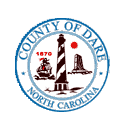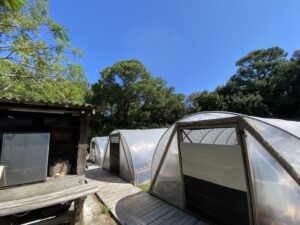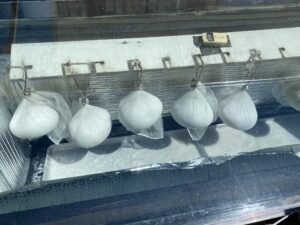Hatteras Saltworks, Buxton, NC
go.ncsu.edu/readext?961404
en Español / em Português
El inglés es el idioma de control de esta página. En la medida en que haya algún conflicto entre la traducción al inglés y la traducción, el inglés prevalece.
Al hacer clic en el enlace de traducción se activa un servicio de traducción gratuito para convertir la página al español. Al igual que con cualquier traducción por Internet, la conversión no es sensible al contexto y puede que no traduzca el texto en su significado original. NC State Extension no garantiza la exactitud del texto traducido. Por favor, tenga en cuenta que algunas aplicaciones y/o servicios pueden no funcionar como se espera cuando se traducen.
Português
Inglês é o idioma de controle desta página. Na medida que haja algum conflito entre o texto original em Inglês e a tradução, o Inglês prevalece.
Ao clicar no link de tradução, um serviço gratuito de tradução será ativado para converter a página para o Português. Como em qualquer tradução pela internet, a conversão não é sensivel ao contexto e pode não ocorrer a tradução para o significado orginal. O serviço de Extensão da Carolina do Norte (NC State Extension) não garante a exatidão do texto traduzido. Por favor, observe que algumas funções ou serviços podem não funcionar como esperado após a tradução.
English
English is the controlling language of this page. To the extent there is any conflict between the English text and the translation, English controls.
Clicking on the translation link activates a free translation service to convert the page to Spanish. As with any Internet translation, the conversion is not context-sensitive and may not translate the text to its original meaning. NC State Extension does not guarantee the accuracy of the translated text. Please note that some applications and/or services may not function as expected when translated.
Collapse ▲Brian McMahon is a solar-powered-hoop house-sea salt-farmer. Utilizing the sun and a seemingly endless supply of ingenuity and patience, he harvests salt from seawater, rendering it as pure and natural as possible. Brian, with his wife Shaena, and son Declan, operates Hatteras Saltworks in Buxton.
Brian served in the U. S. Coast Guard and is a surfing enthusiast which led the family to places such as Hawaii, Nicaragua, Mexico, and various Caribbean islands. While spending time in these seaside locations, they were intrigued with the idea and process of making salt. Fun fact: the salt tastes different in each place. Fun fact explained: just as the environment in which grapes are grown imparts a particular flavor to wine (called terroir), geographic location, water, wind, and sun influences the taste of salt. Which is why Brian is smitten with the area off Hatteras Island. “That’s where the Gulf Stream and the Labrador Current converge,” he says, “mixing minerals from the far reaches of the Atlantic Ocean.”
And so, with attention given to tide charts and moon phases and rainfall which affect the salinity of the water, Brian boards the good ship BarNaCle (a nod to sodium chloride, the chemical name for salt). In his retrofitted 22’ Sisu-class powerboat, he cruises through the shimmering blue-green water, skirting frothy white waves, while pelicans dive and dolphins frolic in his wake. He pauses on the vast expanse, readies the pump, and in that slurry of salty goodness proceeds to collect his source water. The seawater is pumped into the large tank which commands most of the boat’s deck space. He then heads back to the island, carrying a boatload of ocean.
Tucked away on a private lot behind a surf shop, surrounded by wax myrtles, pine and oak trees, lies the Hatteras Saltworks “laboratory”, a place of alchemy, where the McMahons work in concert with nature. Look around and behold a testament to the oft-repeated mantra, “Reduce, Reuse, Recycle.” Brian’s regular exercise of scavenging the beach after a storm has resulted in discovering a bounty of reusable materials. Wood from piers, decks, houses, and boats. Discarded fence posts and windows and doors. With his inexhaustible DIY skills, these collected materials found new life in the construction of three hoop houses (a type of solar greenhouse), solar ovens, packing house, and various workstations that all play a vital role in the harvesting and production of salt. “I wanted the business to be as environmentally friendly as possible,” Brian says. Mission accomplished.
The tank of seawater has been offloaded to Brian’s truck and sits at the ready for the next step. The source water is pumped out through several filters, removing sand and other sediments. It is then divvied up among individual tubs and placed in neat rows inside the hoop houses. Here, warm rays of sunshine beam down on the heavy plastic covering, where on some days the temperature inside may reach a balmy 145 degrees. The evaporation process begins.
Good quality, unrefined sea salt can contain up to 87 trace minerals (including magnesium, iron, potassium, calcium, copper, zinc, and phosphorus) giving the salt a more complex flavor than table salt. Slow evaporation is the best method of reducing salt water for mineral retention. “One gallon of water yields about 4 ounces of salt,” says Brian. The process takes 30 – 45 days, depending on the weather.
 The requisite time has passed, and the sun has done its job, the water has evaporated, sodium and chloride ions have bonded and formed salt crystals. At this point, Brian and Shaena move the operation into their North Carolina Department of Agriculture (NCDA) approved packaging facility. Here, they hand pick through the salt, remove any impurities, and break the crystals into flakes.
The requisite time has passed, and the sun has done its job, the water has evaporated, sodium and chloride ions have bonded and formed salt crystals. At this point, Brian and Shaena move the operation into their North Carolina Department of Agriculture (NCDA) approved packaging facility. Here, they hand pick through the salt, remove any impurities, and break the crystals into flakes.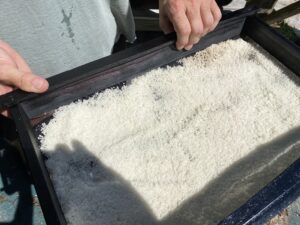
To eliminate any lingering moisture, the salt is bundled into cheesecloth and hung to dry further in solar ovens. This final step also serves to destroy any organisms and is referred to as the “Kill Step.” Working with a scientist from NC State University, Brian was advised that salt needs to be brought up to at least 145 degrees for 15 minutes to ensure the elimination of organisms. “Utilizing just the sun, our ovens reach up to 180 degrees,” says Brian.
The crisp, robust flavor of their pure sea salt is a delight for the taste buds. But Brian and Shaena decided to shake things up by making flavored salts too. Brian’s specialty is cold-smoked pecan salt. He places chips of locally gathered pecan wood inside a smoker with a tray of sea salt. The salt absorbs the nutty, rich aroma and is a flavorful complement to various meats and fish. Shaena makes rosemary sea salt using sun-dried, crushed rosemary leaves, allowing the oils to penetrate the salt. Her other culinary creations include lime, black pepper, lavender, lemon-pepper, garlic, and ginger.
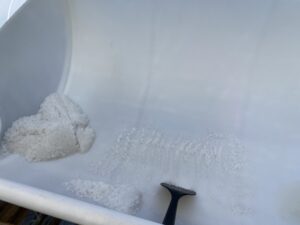 In the NCDA packaging space, Shaena scoops the salt by hand into stand-up bags that are resealable and stamped with the company name, their Hatteras Lighthouse logo, and a description of the contents. She travels to various farmers markets along the Outer Banks to sell their product. Hatteras Saltworks salt can also be purchased through the Hatteras Saltworks website and at several local retailers and restaurants. On social media Shaena shares interesting photos of the salt-making process, great recipes, and a slice of life on Hatteras Island.
In the NCDA packaging space, Shaena scoops the salt by hand into stand-up bags that are resealable and stamped with the company name, their Hatteras Lighthouse logo, and a description of the contents. She travels to various farmers markets along the Outer Banks to sell their product. Hatteras Saltworks salt can also be purchased through the Hatteras Saltworks website and at several local retailers and restaurants. On social media Shaena shares interesting photos of the salt-making process, great recipes, and a slice of life on Hatteras Island.
One hundred percent pure, unrefined sea salt. A gift from the ocean. Brought to you by Hatteras Saltworks



